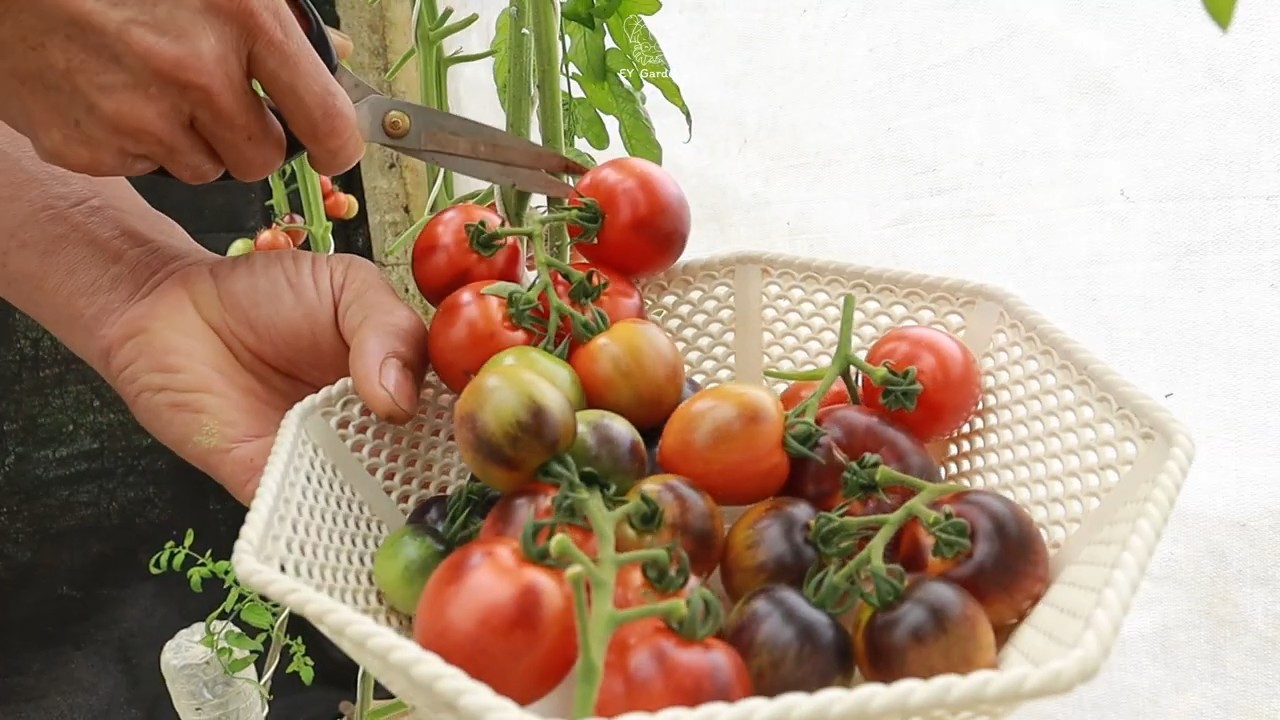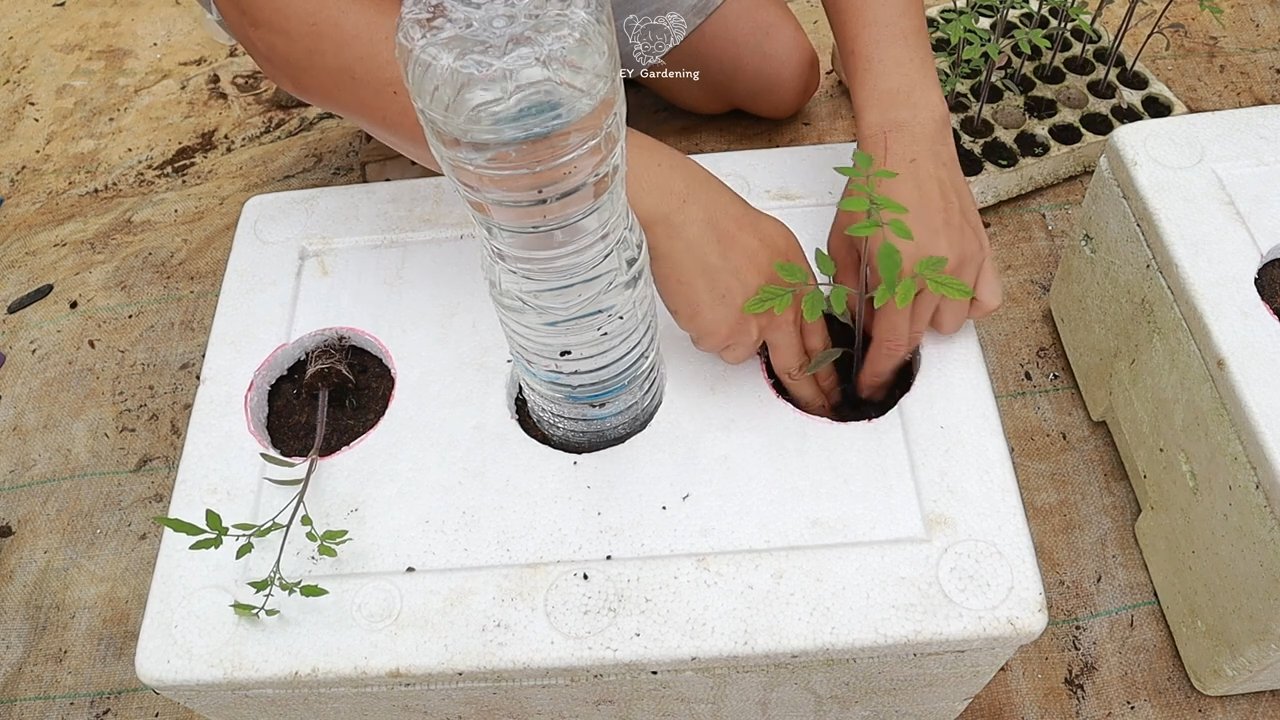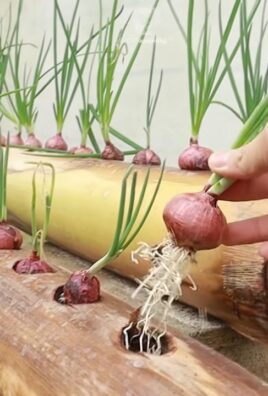Grow Black Tomatoes at Home? Absolutely! Imagine plucking juicy, almost mystical-looking tomatoes straight from your own backyard. It sounds like something out of a fairytale, doesn’t it? But trust me, it’s totally achievable, and I’m here to show you how with some simple DIY tricks.
For centuries, gardeners have been experimenting with different tomato varieties, seeking unique flavors and colors. While the exact origins of black tomatoes are debated, many believe they emerged from cross-breeding efforts in Russia and Eastern Europe, prized for their rich, complex taste and stunning appearance. These aren’t your average supermarket tomatoes; they’re a conversation starter, a culinary delight, and a testament to the magic of home gardening.
Why should you bother learning how to grow black tomatoes at home? Well, for starters, you’ll have access to a flavor profile you simply can’t find in commercially grown varieties. Plus, you’ll know exactly what’s going into your food – no hidden pesticides or questionable practices. In this article, I’ll share my favorite DIY hacks and tips to help you cultivate these beauties, even if you’re a complete beginner. Get ready to impress your friends, elevate your cooking, and experience the joy of harvesting your own delicious, dark treasures!

Grow Black Tomatoes at Home: A DIY Guide
Hey there, fellow gardening enthusiasts! Ever dreamt of biting into a juicy, almost-black tomato, bursting with unique flavor? Well, dream no more! Growing black tomatoes at home is totally achievable, and I’m here to guide you through the entire process. It might seem intimidating, but trust me, with a little patience and the right know-how, you’ll be harvesting these beauties in no time.
Choosing Your Black Tomato Variety
First things first, let’s talk about varieties. “Black tomato” isn’t just one type; it’s a category encompassing several cultivars, each with its own distinct characteristics. Here are a few popular choices:
* Black Krim: This is a classic for a reason! It’s known for its rich, slightly salty flavor and flattened shape. It’s also relatively easy to grow, making it a great choice for beginners.
* Cherokee Purple: Don’t let the name fool you; these tomatoes are more of a dusky rose-purple than truly black, but they’re incredibly flavorful and meaty. They’re also an heirloom variety, meaning they’ve been passed down through generations.
* Black Prince: This variety is smaller and more compact, making it ideal for smaller gardens or containers. It has a sweet and slightly smoky flavor.
* Paul Robeson: Named after the famous singer and actor, this tomato is known for its complex, almost wine-like flavor. It’s a bit more challenging to grow than some other varieties, but the reward is well worth it.
* Japanese Black Trifele: Pear-shaped and beautiful, this tomato has a unique look and a sweet, slightly tangy flavor.
When choosing your variety, consider your climate, available space, and flavor preferences. I personally love Black Krim for its reliability and intense flavor, but experiment and find what works best for you!
Starting Your Seeds (or Buying Seedlings)
You have two options here: starting your own seeds or buying seedlings from a nursery. Starting from seed gives you more control over the process and allows you to choose from a wider variety of cultivars. However, it requires a bit more time and effort.
Starting from Seed:
* Timing is Key: Start your seeds indoors 6-8 weeks before the last expected frost in your area. This gives them a head start on the growing season.
* Gather Your Supplies: You’ll need seed starting trays or small pots, seed starting mix (not regular potting soil!), a spray bottle, and a heat mat (optional, but helpful).
* Sowing the Seeds: Moisten the seed starting mix and fill your trays or pots. Sow the seeds about ¼ inch deep and gently cover them with soil.
* Providing Warmth and Light: Place the trays on a heat mat (if using) and cover them with a humidity dome or plastic wrap to create a greenhouse effect. Keep the soil consistently moist but not soggy. Once the seeds germinate (usually within 7-14 days), remove the humidity dome and place the seedlings under a grow light or in a sunny window.
* Watering and Feeding: Water the seedlings regularly, allowing the soil to dry out slightly between waterings. Once they have their first true leaves (the leaves that appear after the initial seed leaves), start feeding them with a diluted liquid fertilizer specifically formulated for seedlings.
* Hardening Off: Before transplanting the seedlings outdoors, you need to “harden them off.” This means gradually exposing them to outdoor conditions over a period of 1-2 weeks. Start by placing them outside for an hour or two each day, gradually increasing the amount of time they spend outdoors. This will help them acclimate to the sun, wind, and temperature changes.
Buying Seedlings:
* Choose Healthy Seedlings: Look for seedlings that are stocky, green, and free from pests or diseases. Avoid seedlings that are leggy (tall and spindly) or have yellowing leaves.
* Check the Roots: Gently remove the seedling from its pot and inspect the roots. They should be white or light brown and not root-bound (tightly circling the pot).
* Acclimate Before Planting: Even if you buy seedlings, it’s still a good idea to acclimate them to your garden for a few days before planting. Place them in a sheltered spot outdoors and gradually expose them to more sunlight.
Preparing Your Garden Bed
Black tomatoes, like all tomatoes, need plenty of sunshine and well-drained soil. Here’s how to prepare your garden bed:
* Choose a Sunny Location: Tomatoes need at least 6-8 hours of direct sunlight per day.
* Amend the Soil: Tomatoes thrive in rich, well-drained soil. Amend your soil with compost, aged manure, or other organic matter to improve its fertility and drainage.
* Check the pH: Tomatoes prefer a soil pH of 6.0-6.8. You can test your soil pH with a soil testing kit and amend it accordingly.
* Consider Raised Beds: Raised beds are a great option for growing tomatoes, especially if you have poor soil drainage.
Transplanting Your Seedlings
Once your seedlings are hardened off and your garden bed is prepared, it’s time to transplant them!
1. Choose a Cloudy Day: Transplanting on a cloudy day will help reduce stress on the seedlings.
2. Dig a Hole: Dig a hole that is slightly larger than the root ball of the seedling.
3. Add Fertilizer: Add a handful of slow-release tomato fertilizer to the bottom of the hole.
4. Remove the Seedling: Gently remove the seedling from its pot, being careful not to damage the roots.
5. Plant Deeply: Plant the seedling deeply, burying the stem up to the first set of leaves. This will encourage the plant to develop more roots along the buried stem.
6. Water Thoroughly: Water the seedling thoroughly after planting.
7. Mulch: Apply a layer of mulch around the base of the plant to help retain moisture, suppress weeds, and regulate soil temperature.
Caring for Your Black Tomato Plants
Now that your tomato plants are in the ground, it’s time to provide them with the care they need to thrive.
* Watering: Water your tomato plants deeply and regularly, especially during hot, dry weather. Aim to water at the base of the plant to avoid wetting the foliage, which can lead to disease.
* Fertilizing: Feed your tomato plants every 2-3 weeks with a balanced liquid fertilizer.
* Staking or Caging: Black tomato plants can get quite large and heavy, so it’s important to provide them with support. Stake or cage your plants to prevent them from falling over and to keep the fruit off the ground.
* Pruning: Pruning your tomato plants can help improve air circulation, reduce disease, and encourage fruit production. Remove suckers (the small shoots that grow between the main stem and the branches) to direct the plant’s energy towards fruit development.
* Pest and Disease Control: Keep an eye out for common tomato pests and diseases, such as aphids, tomato hornworms, and blight. Take action promptly to control any problems that arise. Organic pest control methods, such as insecticidal soap and neem oil, are often effective.
Harvesting Your Black Tomatoes
The moment you’ve been waiting for! Harvesting your black tomatoes is the most rewarding part of the process.
* Ripeness Indicators: Black tomatoes are ripe when they are a deep, almost black color and slightly soft to the touch. The bottom of the tomato (the blossom end) should also be slightly yielding.
* Gentle Harvesting: Gently twist the tomato off the vine, being careful not to damage the plant.
* Storage: Store your harvested tomatoes at room temperature for the best flavor. Avoid refrigerating them, as this can dull their flavor and texture.
Troubleshooting Common Problems
Even with the best care, you might encounter some problems along the way. Here are a few common issues and how to address them:
* Blossom End Rot: This is a common problem caused by calcium deficiency. It manifests as a dark, leathery spot on the bottom of the tomato. To prevent blossom end rot, ensure your soil is properly amended with calcium and water your plants consistently.
* Tomato Hornworms: These large, green caterpillars can quickly defoliate your tomato plants. Handpick them off the plants or use Bacillus thuringiensis (Bt), a natural insecticide.
* Early Blight: This fungal disease causes dark spots on the leaves and can eventually kill the plant. Remove infected leaves and apply a fungicide.
* Aphids: These small, sap-sucking insects can weaken your tomato plants. Spray them with insecticidal soap or neem oil.
Enjoying Your Homegrown Black Tomatoes
Congratulations! You’ve successfully grown your own black tomatoes. Now it’s time to enjoy the fruits (or vegetables!) of your labor. Black tomatoes

Conclusion
So, there you have it! Growing black tomatoes at home isn’t just a gardening project; it’s an adventure in flavor and a testament to the rewarding experience of cultivating your own food. We’ve walked you through the steps, from selecting the right seeds to nurturing your plants and finally, harvesting those beautiful, dusky fruits. But why is this DIY trick a must-try?
Firstly, the taste. Store-bought tomatoes, even the heirloom varieties, often lack the intense, complex flavor that homegrown black tomatoes possess. The sun-ripened sweetness, the subtle smokiness, and the earthy undertones are simply unmatched. Imagine biting into a juicy, dark-hued tomato, knowing you nurtured it from a tiny seed to a culinary masterpiece. That satisfaction alone is worth the effort.
Secondly, you control the process. You know exactly what goes into your tomatoes – no harmful pesticides, no artificial ripening agents, just good old-fashioned care and attention. This is especially important if you’re conscious about your health and the environment. Growing your own black tomatoes allows you to embrace organic gardening practices and enjoy truly wholesome produce.
Thirdly, it’s a conversation starter! Black tomatoes are visually stunning and a unique addition to any garden or kitchen. Imagine the impressed looks and intrigued questions when you serve a salad featuring these dark beauties. You’ll be sharing not just a delicious meal, but also a story of your gardening prowess.
But don’t stop there! Experiment with variations. Try different black tomato varieties like ‘Black Krim,’ ‘Cherokee Purple,’ or ‘Black Prince’ to discover your favorite flavor profile. Consider companion planting with basil, marigolds, or carrots to enhance growth and deter pests. You can even try growing them in containers if you have limited space. The possibilities are endless!
We encourage you to take the plunge and embark on this exciting gardening journey. Growing black tomatoes at home is not just about producing food; it’s about connecting with nature, learning new skills, and enjoying the fruits (or vegetables!) of your labor. It’s about experiencing the magic of watching a tiny seed transform into a thriving plant, bearing delicious, unique tomatoes.
So, grab your seeds, prepare your soil, and get ready to witness the wonder of growing black tomatoes at home. And most importantly, share your experience! We’d love to hear about your successes, your challenges, and your favorite ways to enjoy your homegrown black tomatoes. Post pictures, share tips, and inspire others to join the black tomato revolution! Let’s cultivate a community of passionate gardeners who appreciate the unique beauty and flavor of these remarkable fruits. Happy gardening!
Frequently Asked Questions (FAQ)
What are the best black tomato varieties to grow at home?
Several excellent black tomato varieties thrive in home gardens. ‘Black Krim’ is a popular choice known for its rich, slightly salty flavor and flattened shape. ‘Cherokee Purple’ is another favorite, boasting a sweet, smoky taste and a beautiful dusky pink hue. ‘Black Prince’ is a smaller, more compact variety that’s ideal for container gardening and offers a tangy, slightly acidic flavor. ‘Japanese Black Trifele’ is pear-shaped and has a complex, sweet, and slightly spicy flavor. The best variety for you will depend on your personal taste preferences and growing conditions. Consider trying a few different varieties to see which ones perform best in your garden and which flavors you enjoy the most.
How much sunlight do black tomato plants need?
Black tomato plants, like all tomato varieties, require at least 6-8 hours of direct sunlight per day to thrive. Sunlight is crucial for photosynthesis, the process by which plants convert light energy into chemical energy for growth and fruit production. Insufficient sunlight can lead to leggy growth, reduced fruit set, and smaller, less flavorful tomatoes. Choose a sunny location in your garden or on your patio for your tomato plants. If you’re growing them indoors, supplement with grow lights to ensure they receive adequate light.
What kind of soil is best for growing black tomatoes?
Black tomatoes prefer well-drained, fertile soil that is rich in organic matter. The ideal soil pH is between 6.0 and 6.8. Amend your soil with compost, aged manure, or other organic materials to improve its drainage, fertility, and water-holding capacity. Avoid heavy clay soils, as they can become waterlogged and inhibit root growth. If you have clay soil, consider growing your tomatoes in raised beds or containers filled with a well-draining potting mix.
How often should I water my black tomato plants?
Water your black tomato plants deeply and regularly, especially during hot, dry weather. Aim to keep the soil consistently moist but not waterlogged. Water at the base of the plant to avoid wetting the foliage, which can increase the risk of fungal diseases. The frequency of watering will depend on the weather, soil type, and size of your plants. Check the soil moisture regularly by sticking your finger into the soil about an inch deep. If the soil feels dry, it’s time to water.
What are some common pests and diseases that affect black tomato plants, and how can I prevent them?
Common pests that can affect black tomato plants include aphids, tomato hornworms, whiteflies, and spider mites. Diseases include early blight, late blight, Septoria leaf spot, and blossom end rot. To prevent pest and disease problems, practice good garden hygiene, such as removing weeds and debris, and avoid overcrowding your plants. Use organic pest control methods, such as insecticidal soap or neem oil, to control pests. Water at the base of the plant to avoid wetting the foliage, and provide good air circulation to prevent fungal diseases. Choose disease-resistant tomato varieties whenever possible. Blossom end rot is often caused by calcium deficiency or inconsistent watering. Ensure your soil has adequate calcium and water your plants regularly.
When is the best time to harvest black tomatoes?
Black tomatoes are ready to harvest when they have reached their mature size and color, and the flesh is slightly soft to the touch. The color will deepen to a dark reddish-brown or almost black, depending on the variety. Gently squeeze the tomato; it should yield slightly to pressure. The stem should also detach easily from the plant. Harvest your tomatoes regularly to encourage further fruit production.
Can I grow black tomatoes in containers?
Yes, you can successfully grow black tomatoes in containers, especially smaller, more compact varieties like ‘Black Prince.’ Choose a large container (at least 15-20 gallons) with drainage holes. Fill the container with a high-quality potting mix. Provide adequate sunlight, water, and fertilizer. You may need to stake or cage your tomato plants to provide support.
How can I improve the flavor of my homegrown black tomatoes?
Several factors can influence the flavor of your homegrown black tomatoes. Ensure your plants receive adequate sunlight, water, and nutrients. Avoid overwatering, as this can dilute the flavor. Allow the tomatoes to ripen fully on the vine before harvesting. Consider adding Epsom salts to the soil to provide magnesium, which can enhance flavor. Experiment with different black tomato varieties to find the ones that best suit your taste preferences.
What are some creative ways to use black tomatoes in cooking?
Black tomatoes are incredibly versatile and can be used in a variety of culinary applications. They are delicious sliced and eaten fresh in salads, sandwiches, or as a snack. They can also be used to make sauces, soups, salsas, and chutneys. Their unique flavor and color make them a standout ingredient in any dish. Try roasting them with herbs and garlic for a flavorful side dish, or use them to make a black tomato gazpacho. The possibilities are endless!




Leave a Comment